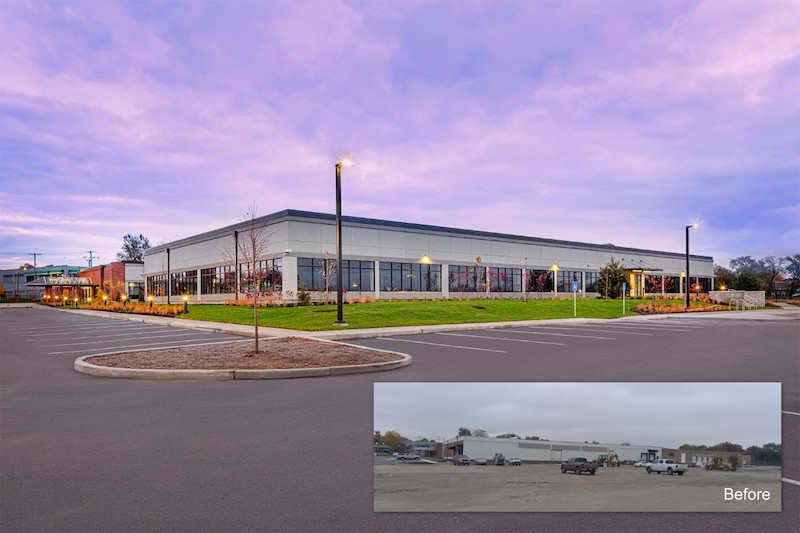KWK Architects is currently leading a project to repurpose nearly eight acres of industrial space into new office space for the Washington University School of Medicine (WUSM).
The original site included two single-story structures and a warehouse building totaling 183,900 sf. An existing 100,000-sf warehouse and associated infrastructure on the site were demolished to allow for the redesign. A smaller warehouse was able to remain on the site for adaptive reuse and an existing 65,000-sf warehouse was repurposed fo WUSM’s new office space and a 600-space secured parking lot.
KWK designed a new facade and roof for the single-story warehouse to bring it up to current energy codes and update the appearance. A new storefront and north- and east-facing sloped skylights bring daylight into the building’s interior spaces. The skylights were aligned with the central corridors to provide ample lighting in the building’s interior spaces.
Phase 1 of the project included 20,000 sf including office fit-outs for the Department of Orthopedics, Department of Pediatrics, and Department of Neurology. Phase 2 completed 45,000 sf of space and included the Office of Vice-Chancellor of Research and Physician’s Billing Services. Phase 3 has begun planning for 35,200-sf of additional office space. Once completed, the building will house nearly 500 employees.
Related Stories
| Jun 2, 2014
Parking structures group launches LEED-type program for parking garages
The Green Parking Council, an affiliate of the International Parking Institute, has launched the Green Garage Certification program, the parking industry equivalent of LEED certification.
| May 29, 2014
7 cost-effective ways to make U.S. infrastructure more resilient
Moving critical elements to higher ground and designing for longer lifespans are just some of the ways cities and governments can make infrastructure more resilient to natural disasters and climate change, writes Richard Cavallaro, President of Skanska USA Civil.
| May 28, 2014
KPF's dual towers in Turkey will incorporate motifs, symbols of Ottoman Empire
The two-building headquarters for Turkey’s largest and oldest financial institution, Ziraat Bank, is inspired by the country’s cultural heritage.
| May 27, 2014
One World Trade Center cuts rents due to sluggish activity
Sluggish economy and lackluster leasing force developer The Durst Organization and the Port Authority of New York and New Jersey to reduce asking rents by nearly 10% to $69/sf.
| May 23, 2014
Big design, small package: AIA Chicago names 2014 Small Project Awards winners
Winning projects include an events center for Mies van der Rohe's landmark Farnsworth House and a new boathouse along the Chicago river.
| May 23, 2014
Top interior design trends: Gensler, HOK, FXFOWLE, Mancini Duffy weigh in
Tech-friendly furniture, “live walls,” sit-stand desks, and circadian lighting are among the emerging trends identified by leading interior designers.
| May 22, 2014
Big Data meets data centers – What the coming DCIM boom means to owners and Building Teams
The demand for sophisticated facility monitoring solutions has spurred a new market segment—data center infrastructure management (DCIM)—that is likely to impact the way data center projects are planned, designed, built, and operated.
| May 22, 2014
No time for a trip to Dubai? Team BlackSheep's drone flyover gives a bird's eye view [video]
Team BlackSheep—devotees of filmmaking with drones—has posted a fun video that takes viewers high over the city for spectacular vistas of a modern architectural showcase.
| May 21, 2014
Check out Pandora's posh NYC offices [slideshow]
The new East Coast office for the Internet radio provider is housed on two interconnected floors of the classic 125 Park Avenue building, and features multiple spaces for music performances, large gatherings, and “all hands” meetings.
| May 20, 2014
Kinetic Architecture: New book explores innovations in active façades
The book, co-authored by Arup's Russell Fortmeyer, illustrates the various ways architects, consultants, and engineers approach energy and comfort by manipulating air, water, and light through the layers of passive and active building envelope systems.
















